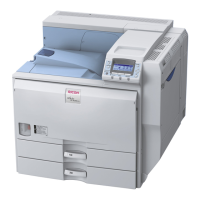Multiple pages are fed at once.
• Check the following:
• Paper guides are set correctly, leaving no gaps between paper guides and paper.
• The side guides of the paper tray are locked.
• Paper guides are not set too tight. If too tight, re-position the guides so that they gently touch the
loaded paper.
• The top of the paper stack is not higher than the limit mark inside the tray, or side guides of the
bypass tray.
See p.89 "Loading Paper".
• Paper not suitable for printing is used. For example, paper may be too thick, too thin, bent or wrinkled,
damp, or already been printed on.
See p.80 "Paper Recommendations".
• When loading paper, fan the paper well before loading.
Paper gets wrinkles.
• Check the following:
• Paper guides are set correctly, leaving no gaps between paper guides and paper.
• The side guides of the paper tray are locked.
• Paper guides are not set too tight. If too tight, re-position the guides so that they gently touch the
loaded paper.
• The top of the paper stack is not higher than the limit mark inside the tray, or side guides of the
bypass tray.
See p.89 "Loading Paper".
• Paper not suitable for printing is used. For example, paper may be too thick, too thin, bent or wrinkled,
damp, or already been printed on.
See p.80 "Paper Recommendations".
• The fusing unit is deteriorated or damaged. Replace the unit.
See p.121 "Replacing Maintenance Kit B".
The back of the paper is printed on.
• The paper has been loaded upside down.
Load paper in the 500-sheet paper trays or 2000-sheet paper feed unit with the print side up. Load
paper in the 1200-sheet feed unit or bypass tray with the print side down.
See p.89 "Loading Paper".
Duplex printing cannot be performed.
• Paper is loaded in the bypass tray. Duplex printing cannot be done from the bypass tray.
9. Troubleshooting
160

